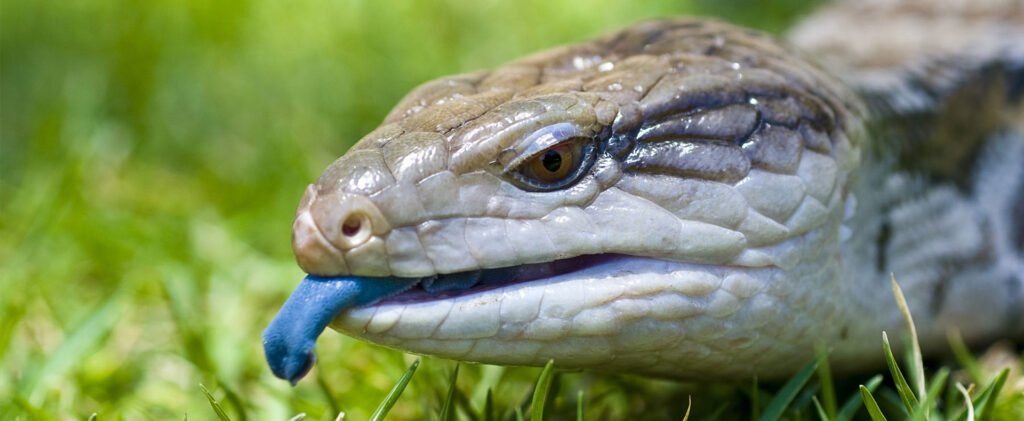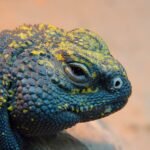Let’s explore another fascinating reptile pet: the Blue-Tongued Skink.
Blue-Tongued Skinks: The Charismatic Lizards with a Colorful Secret
Discover the world of Blue-Tongued Skinks. Learn about their care, unique features, and why they’re becoming increasingly popular as pets. Comprehensive guide with expert tips for both novice and experienced reptile keepers.
blue-tongued skink, Tiliqua species, lizard care, omnivore reptile, exotic pet, skink behavior, reptile husbandry, Australian lizard, blue tongue lizard, pet skink
Blue-Tongued Skinks: The Charismatic Lizards with a Colorful Secret

Introduction to Blue-Tongued Skinks
Blue-Tongued Skinks, belonging to the genus Tiliqua, are fascinating lizards native to Australia and parts of Indonesia. Known for their distinctive blue tongues, which they use as a defense mechanism, these lizards have become increasingly popular as pets due to their docile nature, interesting behaviors, and relatively straightforward care requirements.
Natural History and Origin
Blue-Tongued Skinks are found primarily in Australia, with some species native to Indonesia and New Guinea. They inhabit a variety of environments, from arid deserts to tropical forests. In the wild, these lizards are primarily ground-dwelling and can often be found basking in the sun or hiding under leaf litter.
There are several species of Blue-Tongued Skinks, with the most common in the pet trade being:
- Northern Blue-Tongued Skink (Tiliqua scincoides intermedia)
- Indonesian Blue-Tongued Skink (Tiliqua gigas)
- Eastern Blue-Tongued Skink (Tiliqua scincoides scincoides)
Physical Characteristics
Blue-Tongued Skinks possess several distinctive features:
- Size: Adults typically reach 18-24 inches (45-60 cm) in total length.
- Weight: Generally 300-700 grams when fully grown.
- Body: Robust, elongated body with short legs.
- Head: Large, triangular head with small eyes.
- Tongue: Bright blue tongue, which gives them their name.
- Scales: Smooth, overlapping scales that give them a sleek appearance.
- Colors and Patterns: Vary by species but often include patterns of browns, greys, and oranges.

Blue-Tongued Skink Care: Creating the Ideal Habitat
Providing a suitable enclosure is crucial for the health and well-being of your Blue-Tongued Skink:
- Enclosure Size:
- Minimum size for an adult: 40-gallon breeder tank (36″ x 18″ x 18″)
- Larger enclosures are always better
- Substrate:
- Use a mixture of coconut coir and play sand, or cypress mulch
- Avoid loose substrates that can cause impaction if ingested
- Temperature Gradient:
- Basking spot: 95-100°F (35-38°C)
- Cool side: 75-80°F (24-27°C)
- Nighttime temperature: Can drop to 70-75°F (21-24°C)
- UVB Lighting:
- Provide UVB lighting for 10-12 hours a day
- Use a high-quality UVB bulb designed for reptiles
- Humidity:
- Maintain humidity levels between 40-60%
- Mist the enclosure or provide a humid hide to aid in shedding
- Hides and Decor:
- Offer multiple hides, including a moist hide for shedding
- Provide branches, rocks, and artificial plants for enrichment
- Water:
- Always provide a shallow water dish large enough for soaking

Diet and Nutrition
Blue-Tongued Skinks are omnivores, requiring a varied diet of both animal and plant matter:
- Protein Sources:
- High-quality canned dog food (low in fat)
- Insects such as dubia roaches, crickets, and mealworms
- Cooked eggs (occasionally)
- Vegetables:
- Dark, leafy greens (collard greens, dandelion greens, kale)
- Squash, bell peppers, and carrots
- Fruits (in moderation):
- Berries, papaya, and figs
- Supplements:
- Dust food with a calcium supplement 2-3 times per week
- Use a multivitamin supplement once a week
- Feeding Schedule:
- Adults: Feed every 2-3 days
- Juveniles: Feed every 1-2 days
Common Health Issues
While Blue-Tongued Skinks are generally hardy, they can face several health issues:
- Metabolic Bone Disease (MBD):
- Caused by calcium deficiency or improper UVB lighting
- Symptoms include soft or deformed bones, tremors, and lethargy
- Respiratory Infections:
- Often due to incorrect temperature or humidity
- Symptoms include wheezing, open-mouth breathing, and mucus around the nose
- Parasites:
- Can cause weight loss, lethargy, and abnormal feces
- Regular fecal exams by a veterinarian are recommended
- Obesity:
- Common in captive skinks due to overfeeding
- Can lead to liver problems and reduced lifespan
- Shedding Issues:
- Incomplete shedding can lead to constriction of toes or tail
- Ensure proper humidity and provide a moist hide
Regular check-ups with a reptile veterinarian are essential for maintaining your Blue-Tongued Skink’s health.

Behavior and Handling
Understanding Blue-Tongued Skink behavior is key to successful ownership:
- Diurnal Activity: Most active during the day.
- Tongue Display: Will flash their blue tongue as a warning to predators.
- Docile Nature: Generally calm and tolerate handling well.
- Burrowing: Enjoy digging and burrowing in their substrate.
- Intelligence: Can recognize their owners and may even come when called.
FAQs About Blue-Tongued Skinks
Q: How long do Blue-Tongued Skinks live?
A: With proper care, they can live 15-20 years in captivity, sometimes even longer.
Q: Are Blue-Tongued Skinks venomous?
A: No, Blue-Tongued Skinks are not venomous. Their blue tongue is used as a warning display.
Q: Can Blue-Tongued Skinks be housed together?
A: It’s generally best to house them individually, as they are solitary by nature.
Q: How often do Blue-Tongued Skinks shed?
A: Adults typically shed every 1-2 months.
Q: Are Blue-Tongued Skinks good pets for beginners?
A: Yes, their docile nature and relatively simple care requirements make them suitable for first-time reptile owners.

Estimated Prices for Blue-Tongued Skinks in Different Countries
Please note that these are rough estimates and prices can vary based on the skink’s species, age, and source.
| Country | Estimated Price Range (in local currency) | Approximate USD Equivalent |
|---|---|---|
| United States | $150 – $500+ | $150 – $500+ |
| United Kingdom | £100 – £350+ | $140 – $485+ |
| Canada | CAD 200 – CAD 600+ | $150 – $450+ |
| Australia | AUD 200 – AUD 700+ | $140 – $490+ |
| Germany | €150 – €450+ | $180 – $540+ |
| Japan | ¥20,000 – ¥60,000+ | $185 – $550+ |
Quick Facts About Blue-Tongued Skinks
| Characteristic | Information |
|---|---|
| Scientific Name | Tiliqua species |
| Average Size | 18-24 inches (45-60 cm) |
| Lifespan | 15-20 years in captivity |
| Native Habitat | Australia, Indonesia, New Guinea |
| Diet | Omnivore |
| Temperature Range | Basking: 95-100°F (35-38°C), Cool side: 75-80°F (24-27°C) |
| Humidity Range | 40-60% |
| Activity Pattern | Diurnal |
| Temperament | Docile, good for handling |
| Social Structure | Solitary |
| Unique Features | Blue tongue, large body, small legs |
| Reproduction | Viviparous (live birth) |
| Conservation Status | Not threatened, but some species protected in native habitats |
In conclusion, Blue-Tongued Skinks make fascinating and relatively low-maintenance pets. Their unique appearance, gentle nature, and interesting behaviors provide endless enjoyment for reptile enthusiasts. By providing proper housing, nutrition, and care, you can ensure that your Blue-Tongued Skink thrives and becomes a beloved companion for many years to come.




